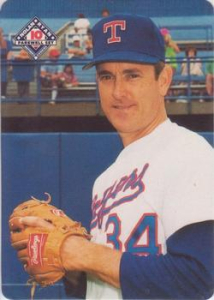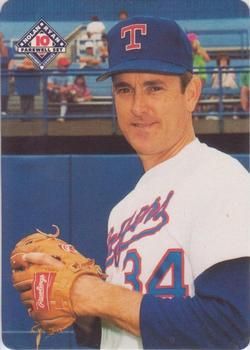August 4, 1993: Ventura, White Sox ‘knuckle under’ against Nolan Ryan, Rangers
In the summer of 1993, the American League’s West Division was a competitive race between the Chicago White Sox, Kansas City Royals, Texas Rangers, and Seattle Mariners. On July 25, the divisional leaders had emerged:
|
Team |
Wins |
Losses |
Percent |
Games Behind |
|
Chicago |
52 |
45 |
.536 |
— |
|
Kansas City |
50 |
47 |
.515 |
2.0 |
|
Texas |
49 |
47 |
.510 |
2.5 |
|
Seattle |
49 |
50 |
.495 |
4.0 |
The White Sox then won six straight, sweeping series against the Cleveland Indians at home and Seattle at the Kingdome. Before the winning streak, Chicago had been in first since June 21 but never led by more than three games. Now the White Sox had some breathing room: a five-game lead over Kansas City and 6½ over Texas.
 Their schedule took them to Arlington for a four-game series against the Rangers beginning on August 2.
Their schedule took them to Arlington for a four-game series against the Rangers beginning on August 2.
The 1993 season was a celebratory one for Rangers fans. In 1994 the club was leaving Arlington Stadium—its home since relocating from Washington, DC, in 1972—for a state-of-the-art facility known as The Ballpark in Arlington. Built in 1959, Arlington Stadium was at first the home of minor-league teams like the Dallas-Fort Worth Spurs of the Double-A Texas League, who played there from 1965 through 1971.1 It had gone through a series of renovations and additions to transform it into a big-league facility, but now the Rangers were getting a home on par with new ballparks like Baltimore’s Oriole Park at Camden Yards.
Rangers fans were also saying goodbye to Nolan Ryan. The 46-year-old fireballer from Refugio, Texas, was winding down a career that lasted 27 seasons, the final five of which were spent with the Rangers. Ryan was the major leagues’ all-time leader in strikeouts. But due to lingering injuries, including a pulled rib-cage muscle, a strained left hip, and arthroscopic knee surgery, Ryan had made only six starts through late July, with a 2-3 record and a 5.58 ERA.
In the first game of the series, Texas scored a run in the bottom of the ninth on a wild pitch to squeeze by the White Sox, 9-8. Chicago squared the series the next day, winning 11-6. Frank Thomas and Robin Ventura combined for seven hits, five RBIs, and three runs, with Thomas’s three-run homer in the second inning, his 28th of the season, giving the White Sox a commanding 9-0 lead after two innings..
In the series’ third game, on August 4, Ryan was facing Chicago’s Alex Fernandez (12-5, 2.99 ERA). The 23-year-old right-hander—born almost three years after Ryan’s September 1966 major-league debut—had won five games in a row from June 27 to July 20 before a loss to the Milwaukee Brewers on July 25 ended his streak.
Chicago scored two runs in the top of the first frame. With one down, Joey Cora walked—increasing Ryan’s big-league record for career walks issued—and Matt Merullo sent a bloop single to left field, giving the White Sox runners on first and second. Ventura singled to left field, and Juan Gonzalez, the Rangers’ left fielder, threw home as Cora headed toward the plate. But the throw was deflected away by the cutoff man, third baseman Dean Palmer. Cora scored and Palmer was charged with an error. Merullo moved up to third on the play.
Right fielder Steve Sax stepped to the plate and whistled a grounder to Palmer, who booted it for his second error in as many plays.2 Merullo scored and the visitors took a 2-0 lead.
It was still 2-0 heading to the top of the third. Merullo popped out to lead off the inning. Ventura was up next, and Ryan plunked the left-handed swinger just below the right elbow. Ventura grimaced in pain, and he took a couple of steps toward first base.
But he gave it a second thought. Ventura threw down his batting helmet and charged the mound.
Looking as though he was wrestling a steer, Ryan muscled Ventura into a hammerlock and proceeded to punch him on the top of his head. After a half-dozen or so knuckle raps by Ryan to Ventura’s head, the benches emptied for a brawl in the center of the diamond.
“All I know was that I was on the bottom of the pile,” said Ryan afterward, “and it felt like their whole bench was on top of me. I was in a bad position on the ground. There’s nothing you can do. You’re at the mercy of your teammates, hoping they can get there and give you some help.”3
Ventura was asked if he thought Ryan hit him intentionally, as retribution for Fernandez hitting Gonzalez. “If you don’t think he did, you don’t know the game,” replied Ventura. “If he’s going to throw at me on purpose, I’ve got to go out there, I don’t care who it is.”4
Ventura, who at age 26 was 20 years younger than Ryan, seemed to take the worst of the scuffle. “He gave me a couple of noogies on my head, but that’s about all,” said Ventura.5 He was ejected from the game by umpire crew chief Richie Garcia for charging the mound.
Chicago manager Gene Lamont was also given an early exit by Garcia. Lamont was incensed that Ryan was allowed to remain in the game. “The punches I saw, Nolan Ryan was throwing them,” said Lamont. “I don’t have any problem with Robin being thrown out. [Ryan] was fighting too.”6
After order was restored, the White Sox’ two-run lead held until the bottom of the sixth inning. The Rangers finally broke through against Fernandez, who had blanked them on three hits to that point. Doug Strange led off with a single to center field. He came home when the next batter, Rafael Palmeiro, smashed his 28th home run of the year, tying the game.
Gonzalez followed with a single to center field. Julio Franco knocked in Gonzalez with his 21st double to break the tie. Iván Rodriguez sacrificed Franco to third. Palmer singled to right field to make the score 4-2. The scoring ended when Dan Peltier doubled home Palmer for Texas’s fifth run of the inning.
Ryan did not give up a hit after the fisticuffs in the third inning. The only blemish was a fifth-inning walk to Cora, who was caught stealing. Ryan went seven innings, struck out five, walked two, and allowed two runs, one earned. His 322nd career win raised his season record to 3-3.
Craig Lefferts and Tom Henke hurled the final two innings to preserve the 5-2 advantage, with the latter earning his 23rd save. Fernandez surrendered five earned runs in six innings, struck out four, and walked one. Fernandez’s record fell to 12-6.
The Rangers won the series finale as well, 7-1, to tie the Royals for second place in the AL West, 4½ games behind Chicago.
As it happened, the White Sox had the last laugh in the division race. They finished August with a 17-12 record and posted a 17-11 mark in September, never relinquishing their hold on the top spot. The South Siders finished with a record of 94-68, while Texas placed second with an 86-76 record, eight games back. The White Sox won the division for the first time since 1983. Like that season, the White Sox were ousted in the ALCS, this time to the eventual World Series champion Toronto Blue Jays in six games.
It was Chicago’s last season in the AL West. Beginning in 1994, baseball major leagues moved to a three-division format, much as the National Football League had in 1970. Chicago was moving to the AL Central Division.
Ryan won two more games in 1993 and retired with a career 324-292 record and 5,714 strikeouts, as well as a major-league record 2,795 walks. He was elected to the National Baseball Hall of Fame in 1999. Ventura played through the 2004 season and finished with 294 homers and six Gold Glove selections.
Arlington Stadium hosted its final Rangers game on October 3, 1993, nearly two months to the day after the Ryan-Ventura brawl. In 22 seasons as a venue for major-league baseball, it was never used for a postseason game or All-Star Game, and the Rangers never finished closer than five games out of first place, outside of the strike-shortened 1981 campaign.
Still, Ryan’s retaliatory pitch, Ventura’s ill-advised charge, and the melee that followed gave the ballpark its most memorable and iconic moment, with a lasting fame that symbolized Ryan’s “Texas tough” image.
Acknowledgments
This article was fact-checked by Mark Richard and copy-edited by Len Levin.
Sources
In addition to the sources cited in the Notes, the author consulted Baseball-Reference.com and Retrosheet.org for pertinent information, including the box score and play-by-play.
https://www.baseball-reference.com/boxes/TEX/TEX199308040.shtml
https://www.retrosheet.org/boxesetc/1993/B08040TEX1993.htm
Notes
1 Will Osgood, “Arlington Stadium,” SABR BioProject, Accessed December 24, 2022. https://sabr.org/bioproj/park/arlington-stadium-texas/.
2 Steve Sax was primarily a second baseman from 1981 to 1992. In 1993 he shifted to the outfield and designated hitter.
3 Simon Gonzalez, “Ryan Struts Stuff in Victory: White Sox Overtaken After Brawl,” Fort Worth Star-Telegram, August 5, 1993: C-5.
4 Tony DeMarco, “Ryan’s Aim a Sore Spot in Chicago,” Fort Worth Star-Telegram, August 5, 1993: C-1.
5 Joey Reeves, “Sox Fighting Mad in Loss: Brawl Erupts After Ventura Charges into Ryan,” Chicago Tribune, August 5, 1993: 4-4.
6 DeMarco, C-5.
Additional Stats
Texas Rangers 5
Chicago White Sox 2
Arlington Stadium
Arlington, TX
Box Score + PBP:
Corrections? Additions?
If you can help us improve this game story, contact us.


